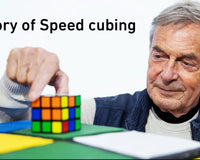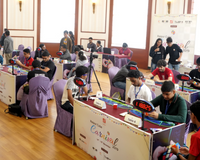Algorithms are an essential part of speedcubing, especially for the last layer of the CFOP method. There has been a lot of time dedicated to finding the best algorithms for each case since the beginnings of the cube’s invention, leading to the development of many algorithm subsets. Which ones would be the most useful for a 3x3 solver? And are they really necessary?
OLL & PLL
These are the two most common algorithm sets for the last layer: OLL orients all the last layer pieces and PLL permutes them to solve the cube. These two are pretty much necessary if you want to get faster to sub-20 or sub-15 levels. PLL has 21 cases and OLL has 57, though these aren’t as many as you might think, because many OLL cases are just mirror versions of another case.
For the other subsets, the most important thing to keep in mind is efficiency versus speed. There are two factors affecting your speed: turns per second and recognition time. If you learn a huge number of algorithms for specific cases, it takes you significantly more time to recognize them compared to easy and distinct cases like PLL or OLL. After that, you would have to
execute the correct algorithm with the best finger tricks. Doing this: learning all the algorithms and then training yourself to recognize much faster takes a lot of time. Is it really worth it?
ZBLL
ZBLL for example, which solves the entire last layer in one step from a position of all edges being oriented, has a whopping 493 cases. It gives you a slight advantage, combining both orientation and permutation into one step. But you would have to learn close to 500 algorithms and then practice them, again and again, to recognize them during solves. One infamous example is Anthony Brooks. He had just recently learned ZBLL but completely failed in his competition results because he took so long to recognize each case that it negated every advantage.

Winter Variation
So what about something smaller? Winter Variation is a subset that combines OLL with the last F2L pair, if the top cross of 4 edges is oriented. There are 27 Winter Variation cases, much less compared to something massive like ZBLL. But there is one important point to remember here. Always judge subsets by their ability to give you a proper advantage over regular solutions. If the advantage is too little for too great a cost like ZBLL, it won’t be worth it. In this case of Winter Variation, it is possible to learn 27 cases fairly quickly and apply them, but there are many cases where it might just be better to insert the pair and do the OLL.

What subsets should you learn?
There are tons of algorithm subsets out there: ZBLL, COLL, VLS, Winter Variation, and so on. People would not have put so much time into developing them if they didn’t give you at least some advantage, despite everything I’ve said against it. So what would be the best way to take advantage of all this knowledge without wasting too much time? Every subset will have at least some number of amazing solutions for hard cases. There are some 6-8 move Winter variation cases that are very easy to recognize and execute to skip OLL. There are some ZBLL cases that are much better than just solving OLL and PLL, which are also easy to recognize.
One Winter Variation algorithm I use to solve the case below for example is (R U R’ U’) R U’ R’, which is just the sexy move followed by inserting the pair to skip OLL.

My suggestion, and what I do, would be to go through a list of these algorithms and pick out those that are easy to recognize: having blocks of the same colour for example. Then try and see if that solution works better for you compared to the usual way you would solve the case. Of course, the new algorithm will be harder at first but keep going and see if it works. Picking and choosing algorithms from each subset that give you the most advantage is a great way of using the vast resources available while also not investing lots of your precious time. This isn’t to discourage you from learning these subsets if you want to, but I would recommend starting out with this kind of approach to ease yourself into learning new, advanced algorithms.
About Author

Pranav Prabhu
Pranav Prabhu is the current 3x3 Fewest Moves (Single) National record holder from Chennai. He started cubing when he was 14 and has 5 years of cubing experience. Besides cubing, Pranav enjoys reading books, writing, and playing the piano. He has participated in 36 competitions and won 30 podiums including 8 gold medals and 1 National record.































2 comments
MOHMMAD haazim
Solving cube
Anmol Singh
which is the fastest method maximum cubers do to get sub 10